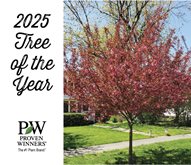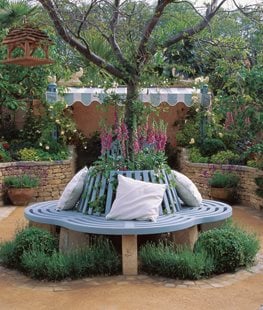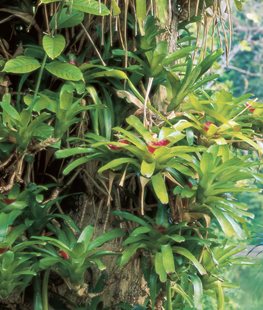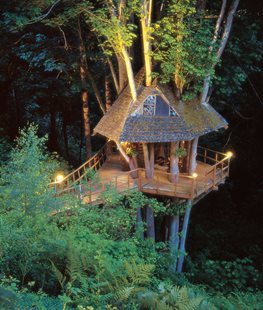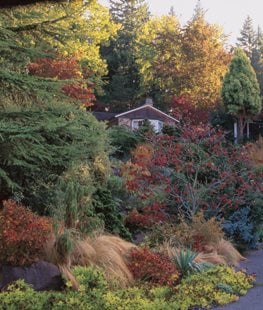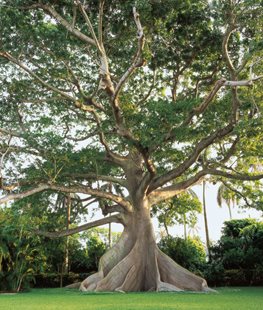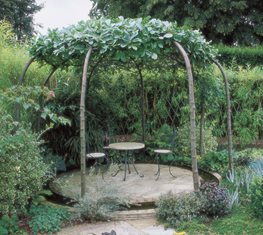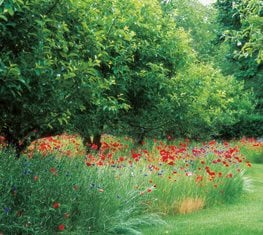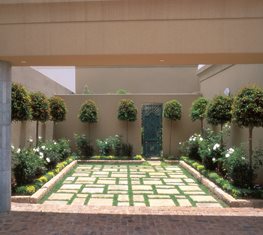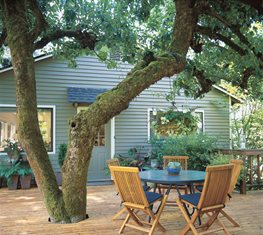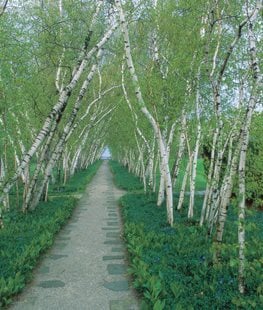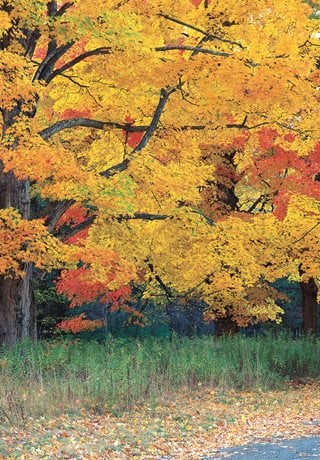10 Great Design Ideas for Trees
Discover how to make the most of new and old trees alikeWe are naturally drawn to trees. Their canopies form outdoor rooms. A pair frames a view, an avenue makes a sheltered walk. Trees make a garden beautiful—as these great ideas prove.
1. Life's a Bench
Making a livable space outdoors can be as simple as a couple of pillows and a bench under a tree. English designer Bunny Guinness created this idyllic cottage courtyard around a Higan cherry (Prunus x subhirtella ‘Autumnalis’). The choice of tree was shrewd—it is long-lived, and this variety flowers twice a year.
2. Plant a Tree
In hot climates trees are potential niches for a whole range of other plants—orchids, ferns, bromeliads and vines. The host tree here is Lagerstroemia speciosa, a tropical specimen that is a natural home for bromeliads, packed in moss and wired to the trunk. In colder areas you’ll achieve a similar luxuriance with a rose or clematis trained through an old tree.
Tip: Rosa banksiae ‘Lutea’ is a good rose to cover a tree—vigorous with masses of flowers.
3. Tree Top Retreat
It takes a special type of tree to accommodate humans who want to sleep among its branches and a special type of builder to make the dream come true. This clump of five Oregon maples (Acer macrophyllum) in Washington state forms the heart of a hexagonal treehouse reached by a cantilevered bridge from the hillside.
4. A Sense of Place
This fall scene at the Elisabeth C. Miller garden in Seattle shows how trees can anchor a house in the landscape. The key to fitting in, when planting the outer reaches of the garden, is to use natives or only those exotics that mimic the form and scale of the natives—in this region, Western red cedars and Douglas firs. The scene still looks essentially Northwestern, even though many of the trees are nonnatives. “Alien” shapes and forms fit in closer to the house. The prominent tree in the foreground is Acer japonicum ‘Aconitifolium’, and Fothergilla gardenii is massed at the foot of the slope.
5. Symbol of Life
The amazing buttress roots of the kapok tree (Ceiba sp.), a member of the baobab family, inspire awe in mere mortals—oaks and cedars command the same respect in cooler regions. Such giants are suited only to large estates, but the ancient custom of planting a tree for posterity or to mark the birth of a child can be carried on in the average garden.
Tip: These medium-sized trees would make a magnificent legacy: Sourwood (Oxydendrum arboreum); paperbark maple (Acer griseum); Japanese umbrella pine (Sciadopitys verticillata).
6. Safe Arbor
A ring of whitebeam mountain ash (Sorbus aria), trained into a leafy roof, shows how young trees can be manipulated. By English designer Julie Toll, this feature is halfway between an arbor and a grove—the slender trunks encircle the space like the columns of a building. To achieve this type of effect, start with single vertical trees, about three to four years old.
7. Apple of the Eye
Orchards are an ancient way of farming trees that also pleases the eye—the regular rows follow the contours of the land, yet the formality is never harsh and seasonal changes, spring blossom, summer leaf and autumn harvest, are superconcentrated. Designers have adopted the orchard, partly for its status as an endangered landscape feature and partly for the minimalist appeal of a formal grid with wild underplanting—red poppies in this case.
Pictured: Old orchard of nectarines, apples and peaches in East Hampton, New York.
8. Less is More
Slim manicured trees pack a lot of form and color into a small space. The invisible plane of their level canopies and their regular yet organic forms break up high walls and small urban spaces. The style can be endlessly varied with different underplanting ideas and foot-of-tree treatments, planted or paved, that create a pattern at floor level. Designed by Raymond Hudson, Johannesburg, South Africa.
Tip: These trees make single-stemmed umbrellas that spell urban chic: Portugal laurel (Prunus lusitanica), Strawberry tree (Arbutus unedo), boxwood.
9. View from a Deck
This deck, in a garden in Woodinville, Washington, makes a usable space close to the house and has the benefit of preserving an inconvenient yet wonderful 65-year-old moss-covered apple tree. Arthritic it may be, but hung with lights and a mossy wire foliage basket from Ravenna Gardens, it makes a romantic spot in the evening. When paving an area under existing trees, remember to allow for radial growth of the trunk and try to keep root disturbance to a minimum.
10. Walk the Line
The birch walk at Stan Hywet Hall in Akron, Ohio, designed by Warren H. Manning from 1911. The trees (Betula papyrifera), underplanted with blue periwinkle (Vinca minor) and lily-of-the-valley (Convallaria majalis), lean toward each other as if by natural disposition, yet it took some art to create that gentle gothic arch. Such naturalness is a hallmark of the Craftsman style of the times.
Tree Tips:
“Trees, except in the tiniest of gardens, are the prime ingredient of a beautiful view.”
—Graham Stuart Thomas
- Fall is the traditional time to plant trees. Container-grown specimens are available all year, but for bare-rooted trees the lifting season runs from November to the end of April.
- Michael Dirr is the acknowledged authority on American trees and shrubs. His book Dirr’s Encyclopedia of Trees & Shrubs is a valuable reference (Timber Press).
- Espalier specialist Henry Leuthardt Nurseries of Long Island suggests making garden houses out of apple and pear trees. Use single verticals or fan-trained trees.
Thanks to Richard Schulhof of the Arnold Arboretum, Boston, for his advice. For ideas on using trees and which types would work in your garden, visit your nearest arboretum.
Thanks to Consulting Editor Ruth Chivers.
Related:
Espalier Trees
Planting Ideas
